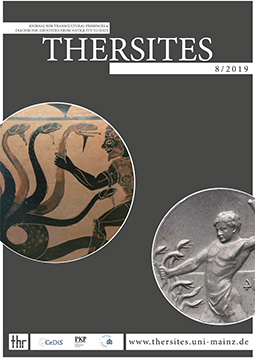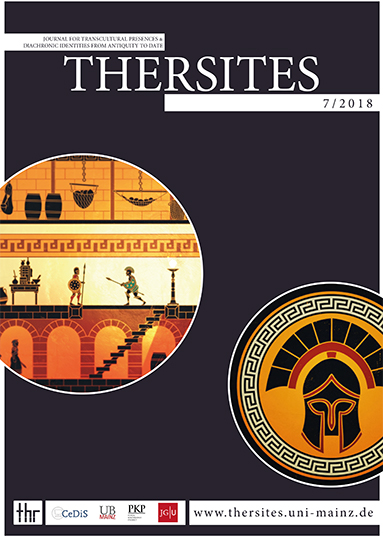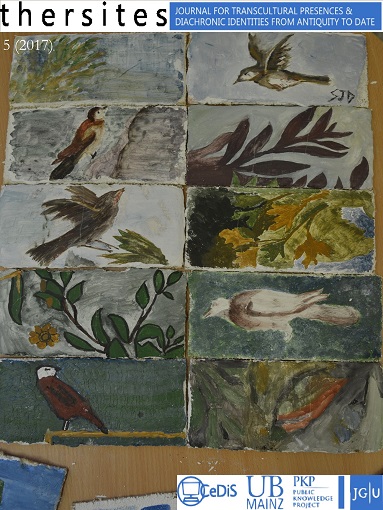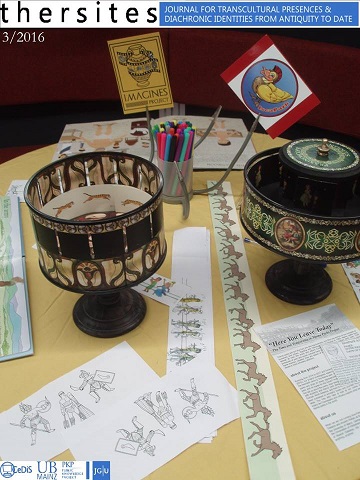Archives
-

Antiquipop – Chefs d’œuvres revisités (ed. F. Bièvre-Perrin)
Vol. 13 (2021)This special issue hosts the proceedings of a workshop that took place in Lyon in 2019, dedicated to discussing the modern receptions of some "masterpieces" from ancient Greek art.
-

tessellae – Birthday Issue for Christine Walde (ed. Annemarie Ambühl)
Vol. 11 (2020)This special birthday issue for Christine Walde, co-founder and co-editor of thersites, features contributions from colleagues and friends. The articles, essays, and book reviews, centering around the honoranda’s research interests as well as focusing on core topics of thersites, form a thematically varied mosaic (tessellae): innovative constructions of literary genres and poetics (especially bucolic, elegy, epic, and epigram), images of the city of Rome and its counterparts, sleep and dreams, history of classical scholarship, gender studies, and classical reception studies.
-

Modern Identities and Classical Antiquity
Vol. 10 (2019)Studies on the “uses of the past” have steadily and consistently advanced over the past twenty years. Following the seminal studies by Hobsbawm and Ranger and Benedict Anderson on the role of narratives of the past in constructing (national) identities, and thanks to the development of the academic field of reception studies, the attention for cultural memory and lieux de mémoire has been steadily growing over the past two decades. Many publications have thus investigated the role of nearer and further time layers in defining and determining structures of identity and senses of belonging across the world. Didactics of history has also contributed a great deal to this field of studies, also thanks to the always more refined methodologies of school book analysis. Classical Antiquity has obviously not been neglected, and much research has been dedicated to its role in the development and reinforcement of modern identities. Yet, not only some areas of the world have remained less considered than others, but most attention has been dedicated to national identities, nationalistic discourses, and their activation through historical narratives. This special issues of thersites wants to contribute further to research on the role of Classical Antiquity within modern identities, asking scholars to focus especially on the geographic and thematic areas that have been until now less strongly represented in scholarship. A reviews section completes the volume, presenting to the reader and discussing recent literature on the subject.
-

Ancient Greek and Roman Multi-Sensory Spectacles of Grief
Vol. 9 (2019)Is grief for the death of a loved one a universal, trans-historical emotion? What role does the historical, political and socio-cultural context play in how grief is understood, processed, performed, written about and represented in art? This special issue of thersites seeks to address these questions with reference to the cultures of ancient Greece and Rome. Drawing on a wide range of both textual and material culture evidence, the six papers that make up this issue investigate how the ancient Greeks and Romans reacted to the death of relatives, friends and members of their wider community, and how it affected their lives, societies and sense of identity. The first half of the issue is devoted to the portrayal of grief in the Homeric epics and Greek tragedy, while the second examines a rich variety of Roman evidence from inscriptions to art, literature and philosophy. Our work intersects with wider debates in the cross-disciplinary field of the History of Emotions, but some of the papers also reference recent scholarship on the senses in antiquity.
-
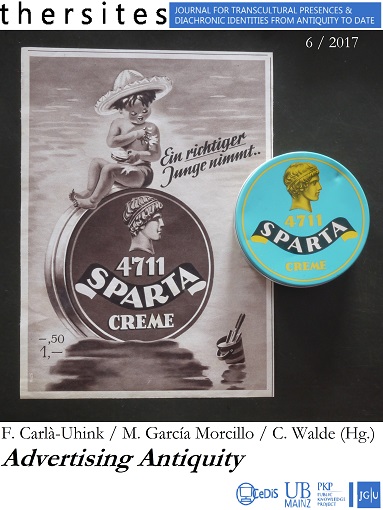
Advertising Antiquity
Vol. 6 (2017)While studies in the field of Classical Receptions have flourished in recent years, in particular regarding the visual and performing arts, advertising has until now been substantially neglected, owing to its (elitist) exclusion from many definitions of “art” or “culture”. But advertising – through its very aim to appeal to a broad public – is a highly relevant indicator of the presence, significance and symbolic value of Classical Antiquity in popular culture. Ancient themes and figures are in fact regularly present in modern Western advertising, constituting familiar reference points in which many of the “values” that ads attempt to communicate find a reliable symbol or pictogram that can be immediately recognized by the public – Hercules (for strength) being possibly the most obvious example. Similarly, the high prestige attributed to the Classical world and its knowledge until just a few decades ago is often used in the Western world to confer an immediate credibility to the product or element being advertised.
Ancient forms of advertising have also been substantially neglected in scholarship, eventually studied only by scholars of ancient economy and almost only ever in reference to Rome. Nevertheless, as is the case today, adverts were part of everyday life for the inhabitants of ancient cities, who covered their walls with offers, promises and public announcements of every kind, private and official. The very term “advertising” derives from the Latin adverto or “turn towards”, hence also “draw attention to” – a word that captures the very essence of advertising. This paves the way to multiple potential approaches that link to social and cultural studies, such as the relationship between advertising and identity.
This relationship is, once again, central to studying the presence of Antiquity in modern advertising: should the audience identify with the Ancient Greeks and Romans, recognize them as a part of their cultural heritage, or should they feel different from them? How is such a message constructed, and what pre-knowledge of the Classical world do the ad-creators expect from their targeted audience?
As within our multimedia saturated world, ads were also acknowledged and perceived in different ways in ancient times. They could be read or seen but also heard, appearing in the form of inscriptions, paintings, and announcements read aloud by the kerykes/praecones.
This issue therefore contains contributions that, whether they concern Antiquity or the modern world, highlight the multimedia character of advertising and interrogate its multisensorial communication and reception. -
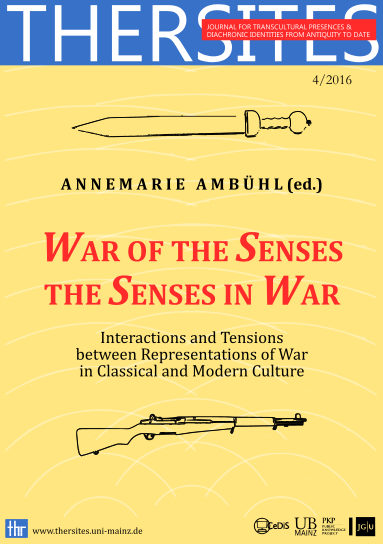
War of the Senses – The Senses in War Interactions and Tensions between Representations of War in Classical and Modern Culture
Vol. 4 (2016)This special issue of thersites (edited by Annemarie Ambühl) addresses artistic representations of war in literature and other media, focusing especially on the role of sensory perceptions and emotions as well as on gender issues. In line with the transcultural and diachronic outlook of thersites, issues of reception are approached either by applying modern theories and methods to the interpretation of classical texts or by comparing and contrasting ancient and modern responses to war and violence and their impact on human beings and society in general. The issue features contributions that range from Homer to postmodern novels and movies, as well as reviews of thematically related recent publications. Within this wide horizon two thematic clusters emerge: One group of papers studies the narratological, aesthetic and psychological dimensions of (fictional) descriptions of battles and other forms of violence in Latin literature, especially in Caesar’s war commentaries and the epics of Lucan, Valerius Flaccus and Statius, while another group of papers looks at novels that directly or indirectly reflect on experiences from both World Wars and the recent wars in Iraq through a complex engagement with classical narratives and concepts derived from classical antiquity.









